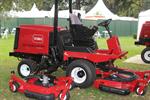 Learn about Horticultural and Agricultural Engineering
Learn about Horticultural and Agricultural Engineering
- Understand how to get the job done easier and more efficiently with modern technological solutions
- Self paced studies; start anytime, study from anywhere.
- University trained, industry experienced tutors
Lesson Structure
There are 9 lessons in this course:
Lesson 1. Surveying
Linear surveying
Triangulation
Determining slope
Triangulation
Contouring
Traversing
Levelling terms
Grid systems - datum line, reduced level, backsight, change point, etc.
Types of Level - dumpy, quickset, cowley
Reading the levelling staff
Levelling procedure
Levelling a sloping site
Lesson 2. Earthworks
Construction machinery and equipment
Bobcats
Front end loader
Tractor
Backhoe
Bulldozer
Explosives
Shovel, Pick
Cut and fill method
Excavation
Contouring and levelling
Swales
Types of Cultivator - Chisel ploughs, discs and harrows, tined cultivators, rotary hoes, etc.
Calculating earth to move
Moving existing earth
Importing soil
Shaping and settling soil
Case Study - Constructing a playing field
Managing Soil degradation -erosion, compaction, salinity, etc
Lesson 3. Water management
Irrigation systems
Sub-surface
Surface
Sprinkler
Trickle irrigation
Irrigation equipment
Watering cans
Sprinklers
Capillary watering
Automated systems
Water - sources, quality, treatment
Pumps - piston, centrifugal, rotary
Filters
Irrigation scheduling
Pulse watering
Lesson 4. Environmental control
Atmosphere control
Carbon dioxide effects
Greenhouse considerations
Covering materials
Temperature control
Benching
Shade houses
Outdoor heating
Lesson 5. Chemical Applications
Applying pesticides
Parts of a basic sprayer
Calibration
Calibrating a knapsack sprayer
Mixing chemicals
Sprayer maintenance
Safe chemical use
Chemical labelling
Material Safety Data Sheet
Safe chemical storage
Environmental contamination
Protecting outdoor structures from chemical contamination
Paints, Stains and Sealers
Painting outdoor furniture and structures
Lesson 6. Fencing
Fencing materials - wire mesh, barbed wire, wire strand, posts, strainer assemblies etc
Traditional wire fencing
Semi-suspension fencing
Suspension fencing
Electric fencing
Box end assembly
Post and stay assembly
Barriers and walls
Types of timber fence -panels, slats, pickets, hurdles
Fencing houses and pools
Gateways and gates
Rock and rubble walls
Brick walls
Concrete walls
Free standing walls
Retaining walls
Trellises
Wood engineering - softwoods, hardwoods
Preservatives
Hedges
Lesson 7. Mechanisation
Vehicles
Tractors
The clutch
The transmission
Harvesters
Mowers - rotary, cylinder, flail, ride on
Hedge trimmers - shears, blade, saw, flail.
Trimmer maintenance
Chain saw use
Chain saw characteristics - petrol, electric, bar size, etc
Chain saw maintenance; extending chain life
Safety with chain saws
Mulching machines
Cultivators
Milking machines
Soil mixing machines
Potting machines
Planters, seeders, drills
Harvesters - potato, carrot
Grading machines
Lesson 8. Engineering efficiency
Overview
Costs
Quality of product
Replacement parts and servicing
Lesson 9. Developing engineering solutions
Introduction
Handling equipment
Trays boxes, pellets
Trolleys and barrows
Trailers
Fork lifts
Tractor loaders
Continuous conveying systems - conveyor belts, mono rails, etc
Hoppers
Staff comfort and safety
Each lesson culminates in an assignment which is submitted to the school, marked by the school's tutors and returned to you with any relevant suggestions, comments, and if necessary, extra reading.
Aims
- Explain surveying, including basic principles and techniques, appropriate for horticulture and agriculture.
- Determine earthworks required for an agricultural or horticultural site.
- Determine appropriate water management for an horticultural/agricultural site.
- Determine technological solutions for environmental control problems, in rural or horticultural situations.
- Explain the operation of equipment commonly used to apply pesticides and other chemicals in both horticultural and agricultural workplaces.
- Determine appropriate fencing to use for different purposes; including security and restricting the movement of animals, pests or traffic, in agricultural and horticultural situations.
- Explain the operation of machinery commonly used to mechanise manual tasks carried out in horticultural and agricultural workplaces.
- Evaluate the effectiveness of engineering applications in agricultural and horticultural workplaces.
- Determine procedures for improving work tasks in agricultural and horticultural situations.
Course Duration 100 hours
Learn to Choose and Use Technology that is Appropriate to Needs
With constant technological advancements and in most cases improvements that are occurring these days, people in all walks of industry are often being asked to revise their machinery and manufacturing processes.
Efficiency may be called into question. How do we judge when a process is or is not efficient?
New technology isn't necessarily the best technology to use; but sometimes it is. Inefficient operations are not sustainable, but excessive investment and frequent change might not be sustainable either. Specialisation of technological and engineering solutions has been and will continue to be refined indefinitely. These enable production costs to fall which in turn can be translated into a real terms reduction in product cost.
Often technology goes through a cycle after its development. Initially it is very costly to purchase as research and development costs are often high and need to be met by the technology manufacturer. Technology will only have mild interest from perspective buyers who will be watchful and maybe even critical of a 'newfangled' or innovative concept. Gradually, if the technology is good or sound it will become more widely used, slowly at first, but increasingly as it gains in recognition and is given credit. Finally, the technology becomes widespread and is completely accepted by the community - that is until a newer and better technology is designed to replace it.
From a business viewpoint, you need to be aware of what options exist, then choose the best option in the context of the issue you are dealing with. NOT all technologies are good or effective. Some may be superseded and outdated before they have paid back on the investment made. Others will have an immediate impact on your problems and payback any investment quickly.